Finally I had time to publish a new updated version of my Kindle Remote Page Turner. This time the build will be made using ESP8266 module I got from ebay for about 3$. This module is just brilliant and fits this project perfectly since kindle’s only wireless interface is wifi, so lets start.
What I will be using in this build is one ESP8266 module ESP-03 to be more precisely. There are various packages available, but 03 seems to be perfect combination of size and features (lots of GPIOs). I will just use three gpios in this project two for switches and probably also one for WIFI status led. The first challenge was to solder additional wires to the module to be able to stick it on a breadboard for prototyping. This is what I ended up with: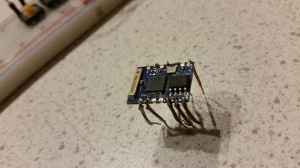
Since this will be battery powered also I need a way to provide a stable 3.3V. I went with a DC to DC converter and a pair of AAA batteries.
I bought a battery case for 3xAAA batteries, but the plan is to use only 2 batteries, and utilize extra space for all the electronics (DC converter, esp8266, 2 resistors and some wiring).
Kindle is prepared as in previous post “Kindle remote page turner” with the addition of cgi scripts for turning the pages via web requests. This modification is very well explained here.
Everything is connected as shown on the schematic
But first I need to program my esp8266 to do what it is supposed. I went with NodeMCU firmware as it proves to have biggest community and using it is very easy. What you need is just NodeMCU Programmer ldownload. and ideally ESPlorer IDE ldownload to make programming nice and flawless. The main ideas for the program are:
1. Put ESP8266 into AccessPoint mode.
2. Configure interrupts to wait for key presses on two selected GPIOs
3. Once interrupts occur send HTTP calls to interface created on Kindle to turn pages forward and back
4. How would I know the ip of kindle. This can be addressed by allowing just two possible IP addresses via mask. This way first one will always be for the host and another for the kindle once it connects. This should be sufficient as I don’t want to allow more than one device to connect anyway.
UNFORTUNATELY THIS APPROACH DID NOT WORK SINCE KINDLE IS UNABLE TO CONNECT TO ACCESS POINT CREATED USING ESP8266 MODULE. COMPUTER DOES! I WILL KEEP DIGGING WHY IT CAN’T BUT UNTIL THEN THERE IS ALTERNATIVE.
the alternative is to put ESP into Station mode and connect to the same network as kindle. This solution has however some shortcomings:
1. you can not use this solution outside of one defined network
2. you have to know details like kindles IP address and program your ESP with these details.
but for testing purposes it is ok. The program looks like:
-- This is the original idea to put kindle into AP mode however kindle is unable to connect-- to the device
--wifi.setmode(wifi.SOFTAP)
--wifi.ap.config({ssid="kindle",pwd="0000"})
--wifi.ap.setip({ip="192.168.1.1",netmask="255.255.255.252",gateway="192.168.1.1"})
wifi.setmode(wifi.STATION)
wifi.sta.config("<SSID>","<PASSWORD>")
tmr.alarm(0, 1000, 1, function()
if wifi.sta.getip()==nil then
print("Connect AP, Waiting...")
else
tmr.stop(0)
print(wifi.sta.getip())
gpio.mode(8,gpio.INT, gpio.FLOAT)
gpio.trig(8,"down",forward)
gpio.mode(5,gpio.INT, gpio.FLOAT)
gpio.trig(5,"down",back)
end
end)
function forward(level)
conn=net.createConnection(net.TCP, false)
conn:on("receive", function(conn, payload) print(payload) end )
conn:connect(80,"192.168.1.14")
--conn:connect(80,"192.168.1.2")
conn:send("GET /cgi-bin/f.cgi HTTP/1.1\r\n"
.."Host: 192.168.1.14\r\n"
--.."Host: 192.168.1.2\r\n"
.."User-Agent: Mozilla/5.0 (Windows NT 6.1; WOW64) AppleWebKit/537.36 (KHTML, like Gecko) Chrome/40.0.2214.115 Safari/537.36\r\n"
.."Content-Type: text/plain; charset=utf-8 \r\n"
.."Accept: */*\r\n"
.."Accept-Encoding: gzip, deflate, sdch\r\n"
.."Accept-Language: pl-PL,pl;q=0.8,en-US;q=0.6,en;q=0.4\r\n"
.."\r\n")
tmr.delay(500000)
end
function back(level)
conn=net.createConnection(net.TCP, false)
conn:on("receive", function(conn, payload) print(payload) end )
conn:connect(80,"192.168.1.14")
--conn:connect(80,"192.168.1.2")
conn:send("GET /cgi-bin/b.cgi HTTP/1.1\r\n"
.."Host: 192.168.1.14\r\n"
--.."Host: 192.168.1.2\r\n"
.."User-Agent: Mozilla/5.0 (Windows NT 6.1; WOW64) AppleWebKit/537.36 (KHTML, like Gecko) Chrome/40.0.2214.115 Safari/537.36\r\n"
.."Content-Type: text/plain; charset=utf-8 \r\n"
.."Accept: */*\r\n"
.."Accept-Encoding: gzip, deflate, sdch\r\n"
.."Accept-Language: pl-PL,pl;q=0.8,en-US;q=0.6,en;q=0.4\r\n"
.."\r\n")
tmr.delay(500000)
end
Layout of the components inside the case:
Finished device looks like this:
Traditionally a short movie showing working device.


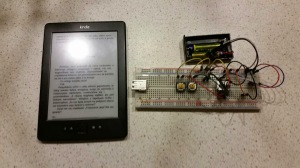
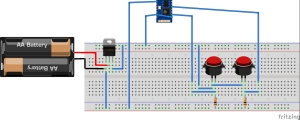
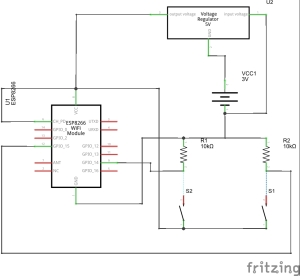
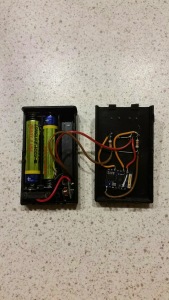
June 30, 2015 at 12:25 pm
Hi Marcin, love your device.
Is there any chance of you adding the schematic for your device? And what brand/type of DC converter did you use?
Thanks a lot.
July 2, 2015 at 9:20 pm
Hello,
glad to hear that you like the project. I used mini DC-DC 0.8-3.3V to DC 3.3V step up converter from Ebay.
http://www.ebay.com/itm/281556288481
About the schematic I will try to attach it to the post soon.
cheers
October 28, 2015 at 6:39 pm
Hi Marcin,
Congratulate to you for your device!! 🙂
Any update on AP mode?
Regards,
R
September 7, 2016 at 3:13 pm
The reason the kindle can’t connect to the AP is that the kindle sends data through the connection and needs to receive a response before it will accept the connection – i.e. you cannot connect to an AP that is not connected to the internet. I tested this by connecting my kindle to my phone through an AP while having my phones internet turned off. The kindle did not like the connection. Perhaps if the ESP can return the data that the kindle is expecting the connection can be made directly to the ESP?
Love the work you have done here. Well done!
December 28, 2016 at 10:26 pm
http://www.mobileread.com/forums/showthread.php?t=266507
March 16, 2017 at 3:32 am
So it turns out that there is something about the NodeMCU implementation that doesn’t play well with the Kindle in AP mode. Using the basic AT-firmware or the more appropriate Arduino IDE to set up an AP does work with the Kindle. An AP can be set up without going through an existing network using the Arduino method. (Note, no arduino board is needed – just a UART – and no firmware is needed to be flashed, just download Arduino IDE, add the ESP as a board and then upload an example sketch to the ESP)
November 12, 2018 at 8:28 pm
Hello.
We are ebook sellers and sometimes people with special needs (e.g. without hand etc) would like to buy such a remote controller for Kindle . Usually price for them is not important, if you know what I mean…..If you are maybe able to sell this kind of devices it would be a good hit!